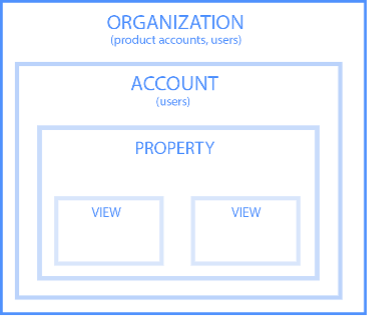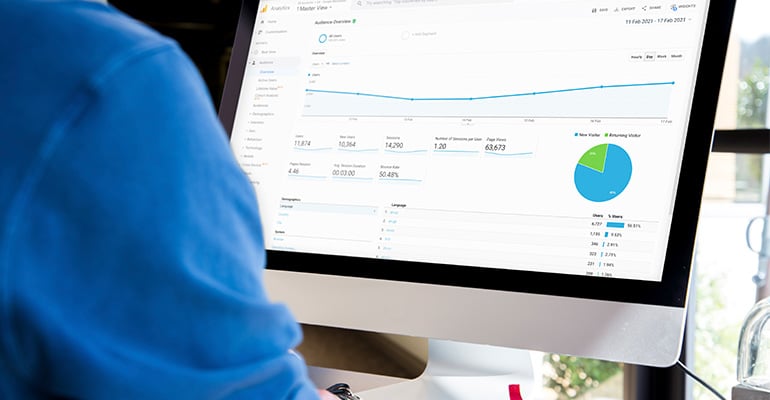Setting Up Your Google Analytics Account For Best Results

As businesses get more complex and the business intelligence (BI) tools available to business leaders become ever more accurate and detailed, it is clear that those organisations that don’t use the data available to them to make their decisions are effectively doing that with only a fraction of the picture. This leaves them at a disadvantage competitively as well as in terms of their growth objectives.
It’s easy to see how difficult it would be to achieve a business objective without a clear idea of the starting point. That is why it is essential that effective data is used to define goals as well as to inform accurate, useful insights for leadership teams, so they can make better decisions.
It’s a virtuous cycle:
- Accurate data helps to define more relevant and achievable goals.
- Insights from this data help to make better decisions and be more reactive to market change.
- Great insights can even highlight previously hidden opportunities and allow businesses to be more proactive.
While there are a number of BI tools that businesses can use to extract rich and detailed insights, we’ve chosen to focus on Google Analytics as it provides outstanding value for free. The platform hosts a goldmine of data that can be turned into useful, actionable insights for the whole business. However, it is essential that it is set up and used correctly because if it is not, the data it provides can be inaccurate and misleading and that can seriously harm decision making, performance and even the bottom line.
This in-depth article is part 1 of a series designed to show you how to ensure that your set up of Google Analytics is in line with best practice so that it provides accurate data. The series will also cover building your reports to extract the reliable information that you need (series part 2) and interpreting that data to deliver the useful and actionable insights your business teams need to achieve your business goals (series Part 3).

How To Get Your Google Analytics Account Set Up Right
Basing your decision on inaccurate data can be damaging and even fatal for a business. Although Google Analytics is a great – and free! – tool, the default set up is not one we would recommend to any business and it should always be adjusted to fit your business requirements and specificities.
N.B. The following article assumes you have a Google Analytics account created for the domain you are working on and you have admin access to it or have the right to set up a Google Analytics account for the domain in question.
Organising your Accounts, Properties and Views
Google Analytics is divided into three hierarchical levels:
- Account – this is usually used to hold all the data for one business and is your access point for Analytics.
- Property – each property usually corresponds to one domain, mobile app or device. You can have up to 50 properties within one account.
- View – each view provides an access point for reports where the data can be further refined however you want it. You can have up to 25 views per property.
In the diagram below, Google added an overarching layer called organisation. This is to represent the layer above Google Analytics where you can manage all your Google tools from the Google Marketing Platform (e.g. Analytics, Tag Manager, Optimize, etc). This layer is optional but can be useful to centralise management of your marketing tools.
Learn more about Google organisations
 Source: Google Support
Source: Google Support
However, before starting to set up accounts, properties and views, you need to carefully think about how they are going to be used within your business. Planning carefully now will help you to structure them in the best way possible for your business to get maximum value from the data. Here are some points to consider when planning your set-up.
User access
Different teams might need to access different reports or different types of information. You might also have external partners who need to access some information whilst other reports will need to be kept confidential. Carefully think about access when structuring your account to ensure that the views for each property allow for these different requirements.
Google Analytics allows you to give users access at different levels. Someone with access to your account will be able to see every level underneath it. However, someone with access to a specific view will not be able to see the data for other views or properties.
For example, international businesses might want their regional team to only access the data that is relevant to their geographical position. Therefore, you may choose to create separate views for each region and give them access to their specific region’s view only whilst HQ might have access to the whole property, allowing them to see each view within it.
Limits
The number of properties and views you can create per account is limited to 50 properties with 25 views per property. Carefully think about your structure and the number of views you will need to ensure you don’t get blocked by the limits. Don’t forget to allow for the future by taking into account your company’s growth plans. Think about geographic changes, acquisitions, expansion plans, channel additions etc. It is well worth checking what your business has planned for the medium term to allow room for that growth in your set up.
For example, imagine you are working on the Google Analytics for a franchise business with hundreds of franchise locations and you need to report on each specific one of them individually. To do that effectively, you will need to split your views into different properties because there are only 25 views per property. You will need to think carefully about how you will split your properties and make sure it’s futureproof. You may split by size of franchise but that may not be future proof because it is subject to change. You might consider splitting properties by franchise type or location instead. Your choice.
If the number of franchises within one region reached the 25 limit, you could create a new property and call it Region 2 for example. We’d recommend keeping track of this in a spreadsheet or database to ensure you know where everything is and who has access to what.
Naming Convention
It sounds basic but make sure you think carefully about how you name the elements of your account. Use simple, logical naming conventions as you create your account structure. Your account should be named after your business, your properties should be named after the domain they represent, and each view should have a clear name that represents the data that you can get. This will make things easier when you’re linking your Google Analytics account with other tools like Google Ads as well as help external partners understand your structure.
For example, naming your account ‘websites’ can make sense for you as a business but if you use external agencies or partners, they won’t be able to recognise your account easily if they have access to others.
We tend to use the following structure:
- Account – Business name e.g. Innovation Visual
- Property – domain name e.g. innovationvisual.com
- View – data set e.g. All Regions Fully Filtered
Review Google’s example account structures

Enabling Features
Analytics has a range of features at account level that you may choose to use. They include Sharing data with Google Products and services, Benchmarking, Technical support, Demographics etc. You should choose which of these features you think would be useful to you and adjust your settings accordingly.
Once enabled, don’t forget to review and update your privacy policy accordingly!
Data Retention
Analytics’ default setting is to retain data for 26 months which is not a long time if you want to analyse trends over longer periods of time. Make sure you change these settings early on to keep your historical data, and again, think about your privacy policy.
Setting up the Right Filters
Once you’ve figured out your structure, you can start setting up your account, property and views. As said before, Google Analytics views are used to visualise your data and run reports. When you set up a view using the default settings, Google Analytics will collect all the data coming from your domain. However, as a business you might not want to focus on all the people (or bots) who visit your site and so you might want to exclude some of your visitors to get better insights from your data.
This is where you can use Google Analytics filters and apply them at the view level. They can exclude certain traffic from your reports, include specific data or change the data you’re getting. Be extra careful how you set them up as they can seriously affect your data. View filters are permanent and are NOT retroactive so they’ll only apply to your data once you’ve created them and you won’t be able to retrieve any data you might have lost by applying them. Plus, they’ll apply in the order you’re adding them so, again, think very carefully and logically before applying them.
If you want to segment your data on an ad-hoc basis, don’t use view filters but instead use segments within your reports. You’ll be able to slice your data without permanently losing any of it.
We recommend creating a TEST view in every property you create, to test your filters before applying them to your actual data. Think of it as a draft where you can make mistakes and practice your filters before adding them to the real, important view. Once you’re happy that your filters work, transfer them to your main view. Don’t analyse data from your TEST view though as it will likely be all wrong!

Examples of View Filters
Filters should be determined by your KPIs, by deciding what it is you need to track. You can work backwards to create a view that analyses the right data to give you the information on that KPI.
There are predefined and custom filters available to choose from. You can find them in the admin section of your account, and they are available at Account and View level. We can’t emphasis enough how careful you have to be when setting filters though. That said, they are vital to the integrity of your data. If you think you’d like some help in setting up your filters get in touch with us, our team have years of experience and can help you get your Analytics Account in tip-top shape.
There are many options to choose from. Here are a few examples of the filters that we use the most:
- Excluding spam traffic and bots – you’re not selling to them, so you don’t care about what they’re doing on your site. Filter them out for better traffic and audience insights.
- Excluding your business, colleagues and partners’ IP addresses – again these aren’t your target audience, and they will distort your metrics as they undertake work online and use your website regularly.
- Make all URLs lowercase – Google Analytics is case sensitive so two URLs with the same text, but different case will be treated as two different pages. This can help aggregate your data for better insights.
- Remove queries at the end of URLs – sometimes tracking codes might get carried over into Google Analytics which means the system will treat it as a separate URL. This also helps to aggregate the data on pages for better insights.
- Include specific geographical locations only – this can help to analyse the data in more depth for a specific country or region. It can also help getting rid of audiences that you don’t target i.e. if you only trade in the UK, you might not want to see US data.
Aggregating your Data
Sometimes going too granular can prevent you from identifying relevant insights or trends. Google Analytics has some default options to aggregate your data but it’s not always 100% accurate. Here are some tips on how to improve the default settings and how to create your own groupings when they’re not available.
Default Channel Grouping
Google Analytics already groups your traffic data by channel to show you where visitors came from. This can provide great insights, but it’s not always 100% accurate. Although it will usually get it right, sometimes Google Analytics doesn’t categorise traffic sources properly. For example, it might group traffic from m.facebook.com under ‘Referral’ when it should be under ‘Social’. Using UTM codes can be a great way to ensure more clarity by telling Google Analytics how to categorise your traffic.
Default channels include ‘Direct’, ‘Organic Search’, ‘Social’, ‘Email’, ‘Affiliates’, ‘Referral’, ‘Paid Search’, ‘Other’ and ‘Display’.

Custom Channel Grouping
However, even with UTM codes, you might sometimes need to rearrange the data by using custom channel groupings. We don’t recommend that you customise the default groupings but rather create a new custom grouping to implement your customisations. Custom groupings allow you to group your data how you want to see it by creating rules that send each session into a group depending on where it came from.
For example, you might want to separate Social from Paid Social and so you can create a Channel Group that contains all the sessions coming from your Social Media ads.
You can also rectify mistakes that Google might make when attributing your sessions to a specific channel.
Looking at your data overall doesn’t really give valuable insights, nor does it help you to look at each session individually. Using these data-driven solutions to group your data can be a great way of getting the answers you’re after and finding great insights for your business.
Learn more on how to create Custom Channel Groupings
Content Grouping
Analysing content by page is an impossible exercise for big sites and isn’t really helpful either. Use Google Analytics’ Content Grouping tool to be able to view your content’s performance by segment. It makes effective use of time but also gives you the level of detail you need to assess performance and decide whether any aspect in that group needs closer attention.
Try to set this up as soon as possible as it is NOT retroactive so any data that you have before won’t be grouped.
This is a great way of analysing your content’s performance by theme or format. You can create different types of content groups to have different angles on your site’s performance.
For example, a Bank might create groupings around Mortgages, Loans, Current Accounts and Savings Accounts whereas a Design Agency might create groupings around Print, Digital, Content, Advertising etc. The better your site is structure, the easier it will be to create content groupings.
Setting up Accurate Tracking
This step is absolutely crucial as it ensures you’re collecting data in the first place. Without going into too many technical details, you need to ensure that your Google Analytics tracking code snippet is showing on ALL the pages you want to track. Ideally, you should have it on all your website pages to ensure continuity in the data as users move across pages.
We usually recommend using Google Tag Manager when setting up tracking for Google Analytics as it’s more flexible. Indeed, it allows you to track everything you should without needing access to the source code of your site, so you can let your developer focus on other issues and manage it yourself. Our article ‘How to Implement Google Tag Manager (GTM) on your Site in 10 Steps’ will walk you through the process. Don’t forget to test your tracking code to make sure it is firing properly.
Campaign tracking
Campaign tracking is essentially a means of filtering traffic by source (where visitors came from e.g. Facebook) and medium (how visitors arrived e.g. social media) in a more granular way. This is used to better identify traffic that is arriving on your website as a result of being exposed to a specific marketing campaign.
This tracking is managed via UTM parameters that are parameters appended to URLs used in the campaign for visitors to click on. The UTM parameter describes the source, medium and campaign so that it is recorded in Analytics and can be segmented and viewed effectively.
Tracking your campaign traffic in this way is a useful way to prove ROI on your marketing activity as well as helping you focus budget on the best performing channels and activity types.
Defining the Right Events and Goals for your Business
Your website has a purpose – for most businesses it is to make money either by directly selling products or collecting leads to sell them services. If you want to understand your website performance, you absolutely need to track events and goals.

Google Analytics events relate to any action taken on your website that you’ve defined, such as playing a video or filling in a form. We usually refer to them as micro goals. Google Analytics Goals are events that you use to measure the effectiveness of your strategy such as filling in a contact form or making a purchase. We refer to them as macro goals.
Again, it is important to carefully think about your goals before you set them up. You should differentiate between macro and micro goals:
- Macro goals are actions that are considered as your primary goals. These actions will usually lead to getting revenue for your business such as making a purchase, filling in a contact form, requesting a demo, etc.
- Micro goals are secondary actions that can lead to macro goals. They don’t lead directly to getting revenue e.g. playing a video, scrolling down the page, etc.
Every business is different and so their definition of a macro and micro goal will likely vary.
We recommend tracking macro goals as your Google Analytics goals and micro goals as events. For example, if you run an ecommerce site, your goals could be to make a purchase and to fill in the contact form when your events could be to leave a review or play a video.
Similarly, for a B2B business, your goals might be to request a demo or download a guide and your events might be to scroll down a blog page or to spend more than 3 mins on a page.
Next Steps After Set-Up
So, now you know the basics of setting up a best practice Google Analytics account and you will be able to accrue useful and, above all, accurate data that delivers the insights you need to plan for your business effectively.
We understand that it’s easy to understand something you are very familiar with but that starting out with Analytics can be daunting. If you would like some help in setting up your analytics or auditing an existing set-up, then why not get in touch? We have many years of experience in setting up effective Google Analytics accounts for a huge range of different businesses and we’d be delighted to help you.
Don’t forget to look out for the next articles in this series coming soon.







